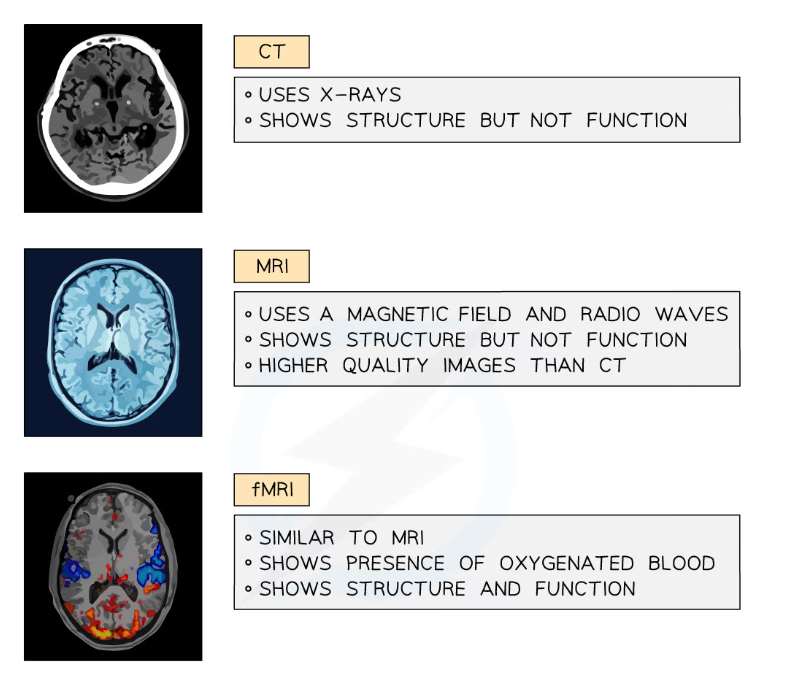- 翰林提供学术活动、国际课程、科研项目一站式留学背景提升服务!
- 400 888 0080
Edexcel A (SNAB) A Level Biology:复习笔记8.2.2 Studying the Brain
Studying the Brain
- Our understanding of brain structure and function is limited
- The brain is incredibly complex and very delicate
- Different regions work together to bring about brain function so can’t be studied in isolation
- It is therefore extremely difficult for neuroscientists to study the brain and find out how it works
- Specialised scanners and techniques can be used to study the brain without having to resort to surgical intervention
Computerised Tomography
- Computerised tomography, or CT, scans produce cross-section images of the brain using x-ray radiation
- A beam of x-rays are aimed at a patient from all angles around the body
- Digital x-ray detectors are used to pick up the x-rays as they exit the patient's body
- Denser tissue absorbs more of the x-ray radiation so shows up as a lighter region on a scan
- A scan produced in this way shows physical structures of the brain and allows visualisation of any tissue damage
- E.g. blood is less dense than brain tissue so a CT scan can be used to locate damaged blood vessels and areas of bleeding after a patient has had a stroke
- The scans don't directly show the functions of the regions of the brain but it is possible to link visible symptoms with the location of any tissue damage
- This can allow neurologists to work out which regions of the brain are responsible for which functions
- CT scans are not recommended for pregnant patients or children due to the risks of exposure to the X-ray radiation, which is given at a higher level than in a normal X-ray
- The risk of damage from such scans is still very low
Magnetic Resonance Imaging
- Magnetic Resonance Imaging, or MRI, uses a combination of a magnetic field and radio waves to generate images through the body
- The patient being scanned must remain very still while inside a large magnet
- Soft tissues can be seen clearly using MRI, and images produced are at a higher resolution than those produced from CT scanning
- As with CT scanning, MRI is useful for identifying areas of abnormal or damaged tissue, but only enables brain function to be analysed by linking damage on a scan with visible symptoms in a patient
- MRI is especially useful for tumour diagnosis as tumours show up clearly in images generated in this way
- MRI scans can therefore be used to identify and locate tumours in the brain
- MRI scans are considerably more expensive to carry out than CT scans but do not carry the risk associated with the use of potentially harmful x-rays
- MRI scans are often the imaging method of choice during long-term therapies
- The magnetic field of an MRI scanner can interfere with medical devices such as pacemakers and insulin pumps, so patients with such devices cannot have MRI scans
Functional MRI
- Functional MRI, or fMRI, functions in a similar way to MRI, making use of a magnetic field and radio waves to generate images of brain structure
- The difference between MRI and fMRI is that fMRI scans allow brain function to be studied in real time
- fMRI scans show the location of oxygenated blood in the brain, therefore indicating which brain regions are active at any one time
- The scanner measures the ratio of oxygenated to deoxygenated haemoglobin
- Patients can be asked to carry out particular actions, answer questions, or think about a specific topic while inside a scanner and the change in blood flow to regions of the brain can be assessed
- The region of the brain associated with the activity or thought will 'light up' in the scanner
- This can be used in medical diagnosis e.g. searching for the cause of seizures, or in psychology research
- fMRI scans show the location of oxygenated blood in the brain, therefore indicating which brain regions are active at any one time
Positron Emission Tomography
- PET scans use radioactive tracers which collect in areas where there is increased blood flow, metabolism, or neurotransmitter activity
- The tracer is introduced to the blood in advance of the scan so that it can be detected by the scanner
- E.g. a radioactive tracer might be radioactively labelled glucose; glucose will be transported in the blood and will be present in high concentrations in metabolically active areas of the brain
- The scanner can detect areas of high radioactivity, and so the movement of the tracer through the body and any accumulation of tracer in the brain can be seen
- The amount of radioactive tracer present in a brain region can indicate whether that region is active or inactive
- This has been useful in building an understanding of specific diseases such as Alzheimer's where brain activity in certain regions decreases
- Neurologists can use the images to study the structure and function of the brain in real time


Some types of scan show only structure, while other allow the study of structure and function in real time
转载自savemyexams

最新发布
© 2025. All Rights Reserved. 沪ICP备2023009024号-1









